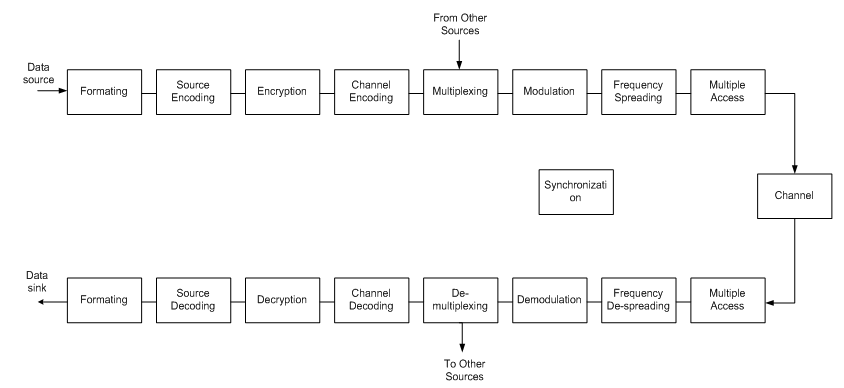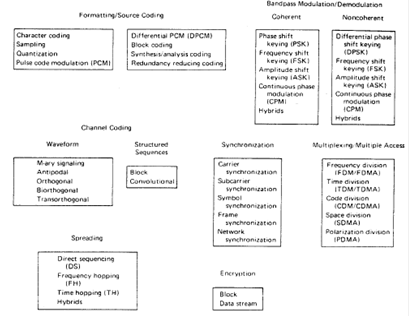Fundamentals of Radio Data Transmission
 The drawing
illustrates the various processing operations applied to digital information
from source to sink. The box labeled “Channel” represents the media through
which data must pass (adapted from Bernard Sklar, “Digital Communications –
Fundamentals and Applications”, Prentice Hall, 2001).
The drawing
illustrates the various processing operations applied to digital information
from source to sink. The box labeled “Channel” represents the media through
which data must pass (adapted from Bernard Sklar, “Digital Communications –
Fundamentals and Applications”, Prentice Hall, 2001).

A basic understanding of how digital information is
transferred by land line or radio links is necessary to fully exploit all of the
features of the WAVECOM decoder. It is assumed that the user is familiar with
the general working of telecommunication systems, in particular radio systems.
The overview below deliberately avoids the mathematical descriptions and proofs
which underly modern communication theory and practice, for the sake of
brevity.
We define digital information as information which
is represented by discrete states of the transmission medium. In contrast,
analogue information is represented by an infinite continuum of states.
For example, live music is analogue information, whereas the same music recorded
on a CD has been transformed into digital information imprinted on the surface
of the disc. Digital information or data is not only text, it can also represent
speech, music or images.
A land line, short wave link, satellite link or any other
way of connecting two points for communications is called a channel.
The tremendous development within electronics and computer
science in the last few decades has led to enormous improvements in the
reliability and robustness of the wireless transmission of digital data, which
has especially benefited the HF spectrum users. The HF frequency range is an
especially hostile environment to communications, as it is prone to both natural
and manmade disturbances of a time-varying nature, e.g., heavy industrial noise,
fierce solar storms, interference from other spectrum users and severe fading.
The ever increasing powers of CPUs has been harnessed via digital signal
processing (DSP) techniques and has resulted in improved coding and modulation
methods such as turbo codes, adaptive equalization, m-ary modulation and
powerful and innovative demodulation and decoding methods. Further improvements
have been made in the field of automation of operations and in the size, power
consumption and features of modern integrated circuits.

Basic digital communication transformations (from B. Sklar,
“A Structured Overview of Digital Communications”, IEEE Commun. Mag, August
1983).
 The drawing
illustrates the various processing operations applied to digital information
from source to sink. The box labeled “Channel” represents the media through
which data must pass (adapted from Bernard Sklar, “Digital Communications –
Fundamentals and Applications”, Prentice Hall, 2001).
The drawing
illustrates the various processing operations applied to digital information
from source to sink. The box labeled “Channel” represents the media through
which data must pass (adapted from Bernard Sklar, “Digital Communications –
Fundamentals and Applications”, Prentice Hall, 2001).
